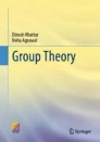- About MAA
- Membership
- MAA Publications
- Periodicals
- Blogs
- MAA Book Series
- MAA Press (an imprint of the AMS)
- MAA Notes
- MAA Reviews
- Mathematical Communication
- Information for Libraries
- Author Resources
- Advertise with MAA
- Meetings
- Competitions
- Programs
- Communities
- MAA Sections
- SIGMAA
- MAA Connect
- Students
- MAA Awards
- Awards Booklets
- Writing Awards
- Teaching Awards
- Service Awards
- Research Awards
- Lecture Awards
- Putnam Competition Individual and Team Winners
- D. E. Shaw Group AMC 8 Awards & Certificates
- Maryam Mirzakhani AMC 10 A Awards & Certificates
- Two Sigma AMC 10 B Awards & Certificates
- Jane Street AMC 12 A Awards & Certificates
- Akamai AMC 12 B Awards & Certificates
- High School Teachers
- News
You are here
Group Theory

Publisher:
Springer
Publication Date:
2023
Number of Pages:
342
Format:
Hardcover
Price:
99.99
ISBN:
978-3031213069
Category:
Textbook
[Reviewed by , on ]
Mark Hunacek
12/30/2023
This is a textbook on basic group theory, based on classroom lectures in India and aimed at sophomore/junior undergraduates there. The material is quite elementary; the only topics covered that might be considered “advanced” are the fundamental theorem of finite abelian groups, group actions and Sylow theory, all of which are covered in roughly the last 50 pages of this book. The rest of the book covers such topics as subgroups, homomorphisms and isomorphisms, direct products, normal subgroups, and quotient (the authors use the word “factor”) groups. The book is apparently the first in a projected series of algebra textbooks, with the second book in the series, on ring theory, already published.
The writing is clear and detailed, and examples (permutation groups, dihedral groups, modular arithmetic groups, etc.) are discussed at considerable length. Solved exercises are interspersed throughout the text, and additional exercises, some but not all of them with hints, appear at the end of each section. These facts, along with the elementary nature of the material, make this book useful for self-study.
This is good because I think that as far as the American college textbook market goes, this book may have something of an audience problem. Not very many American university introductory “groups first” abstract algebra courses are devoted exclusively to group theory. Many try to make room for at least a little ring theory near the end, and typically such courses also begin with an introduction to the basic number theory of the integers, as well as perhaps a discussion of set theory, functions (including 1-1 and onto functions), and equivalence relations (and how an equivalence relation partitions the underlying set into equivalence classes). Although the terms “one-one” and “onto” are used in this book, they are not, as far as I can tell, defined.
Likewise, there are no chapters discussing basic number theory. Instead, the authors rely on the readers’ prior informal experience with the subject. The Division Algorithm, for example, is just assumed as something obvious; my personal view is that it is a good idea to prove it in class after first carefully defining concepts like divisibility, greatest common divisor, etc. The authors also use mathematical induction but do not define it, much less prove it. Nor do they explicitly state the Law of Well Ordering. Equivalence relations are mentioned but never really defined or systematically used. This is, I think, itself a serious problem with the text; equivalence relations are obviously very important and a student should be exposed to them.
The absence of any definition or use of the concept of congruence modulo n creates what I believe to be a genuine mathematical problem. Because the authors cannot define \( Z_{n} \) as the set of equivalence classes of the integers modulo \( n \), they are instead led to define this set as a set of actual integers, and then define addition and multiplication in terms of remainders: the sum and product of \( a \) and \( b\) in \( Z_{n} \) are defined as the remainders when \( a + b \) and \( ab \) are divided by \( n \). The problem is, showing that these operations are associative is awkward and non-trivial, a fact one would not know from the casual way the authors deal with this issue. This is, distressingly, not the only abstract algebra book to make this error; I commented on it earlier in my review of Matsuura’s A Friendly Introduction to Abstract Algebra. I hope this isn’t going to become a trend, because it misleads the student into thinking that something is obvious when it really isn’t.
One question that an instructor might ask, when considering a book for classroom adoption, is: what does this book offer that the existing textbook literature does not? In the case of this book, I’m not really sure. Standard abstract algebra textbooks like Gallian’s Contemporary Abstract Algebra or Hungerford’s Abstract Algebra: An Introduction also offer a good selection of examples and just as much clarity of exposition, as well as better English syntax, a more engaging writing style, a much wider and more versatile selection of topics, and a more careful approach to the modular arithmetic groups that lacks the problems that are present in this text.
Mark Hunacek (mhunacek@iastate.edu) is a Teaching Professor Emeritus at Iowa State University.
See the publisher's website.
- Log in to post comments




